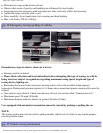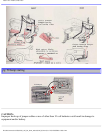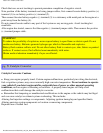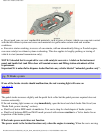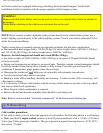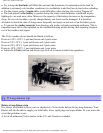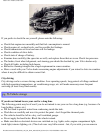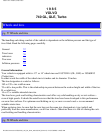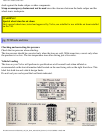
1985 Volvo 740 GL, GLE, Turbo
without the engine running the brake pedal pressure required to stop the car is increased by 3-4 times.
The brake pedal feels stiff and hard.
Moisture on brake discs and brake pads affects braking.
Driving in rain and slush or passing through an automatic car wash can cause water to collect on the
brake discs and pads. This will cause a delay in braking effect when the pedal is depressed. To avoid
such a delay when the brakes are needed, depress the pedal occasionally when driving through rain,
slush, etc. This will remove the water from the brakes. Check that brake application feels normal! This
should also be done after washing or starting in very damp weather.
Severe strain on the brake system
The brakes will be subject to severe strain when driving in mountains or hilly areas. The speed is
usually low which means that the cooling of the brakes is less efficient than when driving on level roads.
To reduce the strain on the brakes it is advisable not to use the brakes excessively.
Instead, shift into a lower gear and let the engine help with the braking. A good rule is to use the same
gear downhill as would be used ascending the same grade. For vehicles with automatic transmission use
position 2 or, in some cases, 1.
Do not forget that, if you are lowing a trailer, the brakes will be subjected to greater load than is normal.
Breaking-in parking brake (hand brake)
To obtain best parking brake performance, the brake linings should be broken-in.
Stop 5-7 times from 30 mph (50 km/h), transmission in neutral, applying the parking brake with the
release button pressed in during the stop.
The force must not lock the rear wheels. If this happens, release the brake enough to let the wheels
rotate. Drive a mile between each stop to cool the brakes. Check for proper parking brake operation.
NOTE:
The brake lights are not illuminated when applying the parking brake. To warn traffic from behind it is
therefore advisable to depress the brake pedal slightly to illuminate the brake lights.
pg. 53 Trailer hauling
When preparing for trailer hauling, observe the following:
● Use a trailer hitch which meets Federal Safely Standards for rear end collisions (FMVSS 301-75). For
trailer weights exceeding 2,000 lbs (908 kgs) use only a trailer hitch offered as Genuine Volvo
Accessory.
An automatic transmission oil cooler must also be installed, since the automatic transmission is subject
to increased load and temperature (certain vehicles are equipped with this extra oil cooler as standard
equipment). Consult your Volvo dealer for further information.
● Maximum trailer weight recommended by Volvo is 3,300 lbs ( 1,500 kgs). Observe legal
requirements of the state in which the vehicles are registered.
file:///K|/ownersdocs/1985/1985_740_GL_GLE_Turbo/85740_03.htm (18 of 22)12/30/2006 7:46:07 AM







